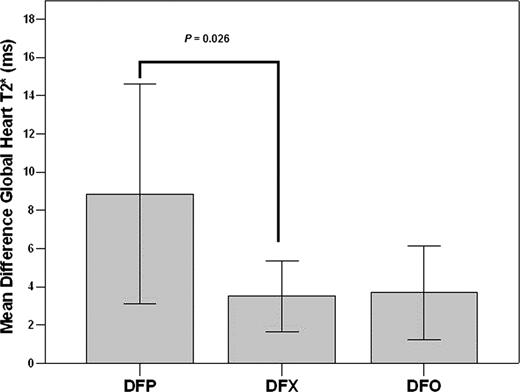Abstract
Abstract 4267
Most deaths in thalassemia major (TM) result from cardiac complications due to iron overload. In thalassaemia available three iron chelation regimes in monotherapy may achieve different changes in cardiac iron and function and liver iron. No data are available in literature about prospective comparisons on cardiac iron and function and liver iron in TM patients treated with deferasirox (DFX) versus deferiprone (DFP) and desferrioxamine (DFO) in monotherapy. Magnetic Resonance (MR) is the unique non invasive suitable technique to evaluated quantitatively this issue. The aim of this multi-centre study was to assess prospectively in the clinical practice the efficacy of the DFX versus DFP and DFO in monoterapy in a large cohort of TM patients by quantitative MR.
Among the first 1135 TM patients enrolled in the MIOT (Myocardial Iron Overload in Thalassemia) network, 392 patients performed a MR follow up study at 18 ± 3 months according to the protocol. We evaluated prospectively the 193 TM patients who had been received one chelator alone between the 2 MR scans. We identified 3 groups of patients: 80 treated with DFX, 39 treated with DFP and 74 treated with DFO. Myocardial and liver iron concentrations were measured by T2* multislice multiecho technique. Biventricular function parameters were quantitatively evaluated by cine images.
The dose of DFX was 26±7 mg/kg/d, DFP was 73±13 mg/kg/d and DFO was 41±6 mg/kg for 5.5 d/wk. Excellent/good levels of compliance were similar in the 3 groups (DFX 99%, DFP 95%; DFO 96%, P = 0.6). Among the patients with no significant myocardial iron overload at baseline (global heart T2* ≥ 20 ms) (DFX 54 pts, DFP 30 pts, DFO 53 pts), there were no significant differences in all 3 groups to maintain the patients without significant myocardial iron overload (DFX 98%; DFP 100%; DFO 98%; P=1.0)
Among the patients with myocardial iron overload at baseline (global heart T2* < 20 ms) in all 3 groups there was a significant improvement in the global heart T2* value (DFX P=0.001, DFP P=0.015 and DFO P =0.007) and in the number of segment with a normal T2* value (DFX + 2.4 P=0.003, DFP +6.0 P=0.031 and DFO + 2.9 P=0.001); only in the DFP group there was a significant improvement in the right global systolic function (+ 6.8% P = 0.016). The improvement in the global heart T2* was significantly lower in the DFX versus the DFP group (P=0.0026), but it was not significantly different in the DFX versus the DFO group (mean difference global heart T2* 3.5 ± 4.7 ms versus 8.8 ± 8.6 ms and versus 3.7 ± 5.5 ms, respectively; P = 0.90) (see the figure). The changes in the mean serum ferritin level and in the global systolic bi-ventricular function were not significantly different among groups.
In patients with liver iron overload at baseline (liver T2* < 5.1 ms), the change in the liver T2* was not significant among groups (mean difference liver T2*DFX 2.1 ± 4.2 ms vs DFO 1.9 ± 3.8 ms vs DFP 1.3 ± 3.3 ms; P = 0.9).
Prospectively over 15 months in a large clinical setting of TM patients DFP monotherapy was significantly more effective than DFX in improving myocardial siderosis, no significant differences were found between DFX and DFO monotherapy.
No relevant conflicts of interest to declare.
Author notes
Asterisk with author names denotes non-ASH members.


This feature is available to Subscribers Only
Sign In or Create an Account Close Modal